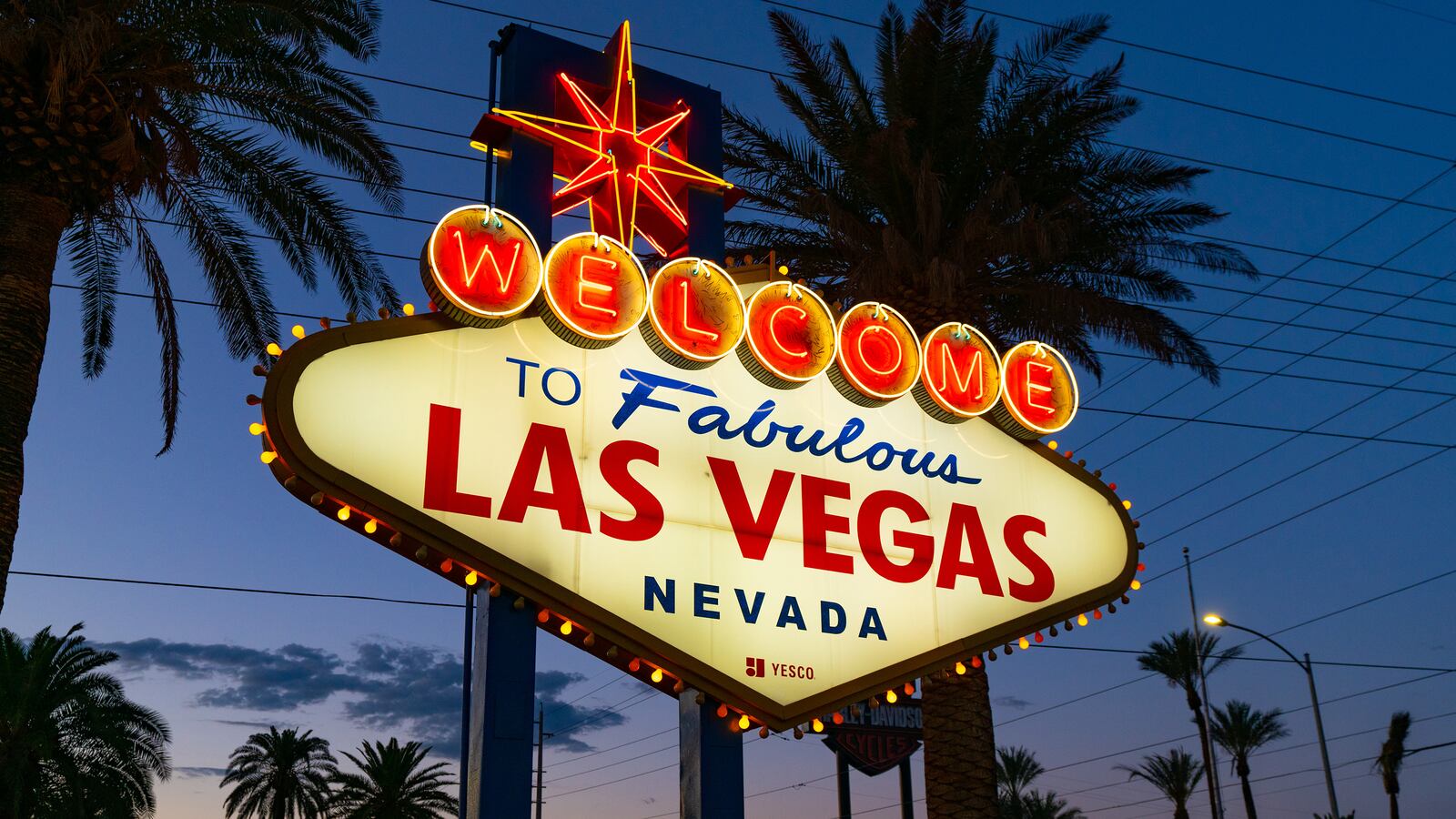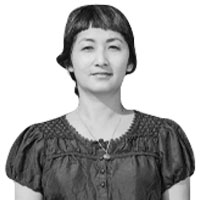Photos of acquaintances standing in front of Las Vegas swimming pools kept showing up on my social media feeds this fall—a summer without end in the post-vaccine edition of this pandemic, and one I wanted in on.
Wandering Vegas for a week I was almost reassured by the numerous sun-bathers sipping decadent drinks poolside without a care in the world, the rowdy bachelorette party running past me through downtown Vegas, a “just married” couple with their sashes of “Mister” and “Mrs.” on Fremont Street, a birthday gathering in a casino with a dozen people in matching t-shirts and a crew all dressed in 1980s gear, ready to party. Restaurants were packed weeknights and weekends, brimming with people enjoying themselves again.
Women like Gwen Stefani and Shania Twain are now the 50-foot stars with ads for their casino residencies on the Strip. The Beatles’ “Love” show reigns at the Mirage, with new acts like comedy-slash-close up magic artist Piff the Magic Dragon at the Flamingo. Magician David Copperfield is still at the MGM. A new Whitney Houston hologram show has people turning heads.
According to Google Flights’ Covid data, 90 percent of flights are operating for travel to Las Vegas, compared to 76 percent for Los Angeles and 63 percent for New York City. If we look at this and some of my empirical evidence, Las Vegas leads the pack in terms of “getting back to normal.”
Months ago, there was much concern over Las Vegas and its relaxed and downright defiant COVID-19 policies. Now in 2021, the city has initiatives like their #VivaVaxVegas program where anyone, locals and out-of-towners alike can get a free COVID-19 vaccine in various places, even inside the casinos. Regardless of vaccination status, casinos have mandated mask wearing, as well as restaurants and bars when you’re not dining or imbibing.
And, yes, there’s the Atomic Testing Museum or the Pinball Museum, but my go to is The Erotic Heritage Museum run by director Dr. Victoria Hartmann and started by the proprietor of the Deja Vu strip clubs Harry Mahoney. It’s provocative, to say the least. The exhibits span from those about African tribes, Weimar, Germany, the history of peep shows, the future of sex in space, to stories of survivors and one about female sexual predators. The museum brings the heat in a multitude of ways and is preparing for a massive expansion.
After a year of it looking like a ghost town, it now looks like Vegas hasn’t missed a beat.
But peer a little closer and you’ll see more than those who came to have a good time. There was the middle-aged dad leisurely riding his pre-teen child on the back of a motor scooter down Sahara Avenue, in no rush. If you wander the residential areas within a few miles of the Strip there’s a lot of house flipping going on, mid-century modern homes being renovated and sold.
In 2011’s Fright Night, a vampire movie that takes place in Las Vegas, the main character Charley Brewster, played by the late Anton Yelchin, says “Nobody lives in Vegas, they just move on through.” This line by screenwriter Marti Noxon hasn’t quite stood the test of time. People do live in and even have families in Las Vegas now. It remains a fantastic town for all sorts of folks to come out of their shells in the bright sunlight, as well as after dark.
Writer and filmmaker Staci Layne Wilson can have her Hollywood dream right in Las Vegas. She lives comfortably 15 minutes from the Strip and says, “now, with the world at our fingertips thanks to the internet, computers, smartphones, etc. The American Dream can be witnessed from anywhere.” She left the bright lights of Los Angeles for the neon of Sin City in March 2020. “Las Vegas was not as locked down (though the Strip was deserted that spring/summer) and the people were more chill—I liked it better right away, even though I was born and raised in L.A., and never thought I’d move. But that decision was made before the pandemic—mainly because of the anti-small business/anti-freelancer tax burdens and bills being passed in California, not to mention the high cost of living and horrendous traffic. I see more of my friends from LA here when they’re visiting than when I lived in LA.”
It’s true—you can pretty much get from one end of Las Vegas to the other in 20 minutes or less. You can have snow 45 minutes north of the city. The stunning views of Red Rock Canyon are just a few miles north of the Strip, by the wealthy area of Summerlin.
Restaurateurs from other cities have set up some in Vegas. For Allan Katz, opening up Jammyland, with his partners, a restaurant and bar in Las Vegas’ Arts District, right near the famous Strip, was a no brainer. He had looked into doing this in Los Angeles, but it would “cost five times more and take lots longer.” Jammyland is beautiful with its gold and green orb lights that hang from the ceiling and a success with a menu that has the headline “unprecedented times call for unprecedented cocktails.” Katz hails from Queens, New York and has made his home in Vegas with his dog Mooncake. Jammyland has a huge patio and caters to the desert city dogs of Vegas.
Andy Nguyen, who was born and raised in Orange County, California is a serial entrepreneur who’s responsible for some Vegas favorites like the Hello Kitty Cafe, Afters Ice Cream and 7 Leaves. He has fond memories of Sin City. “I’ve been going to Vegas so much throughout my entire life. My mom has that gambling blood in her. Going as a kid I have fond memories of crowding ten people into one hotel room at Circus Circus. Waiting in lines to eat at the buffet. Playing games and watching people play away on slots. It began feeling like a second home to me. I was visiting Vegas almost twice a month as a kid. My dad would always do the drive back and forth. I knew when I had the opportunity to open something outside of my California home that Vegas would be the spot.”
In the 1990s series The City The Mob Made, historically Vegas was a safe city where mafia business was conducted out in the desert. In the days of the mob, it was a great place to raise kids. How so you ask? Because the mob kept its business life and family life separate and made the residential neighborhoods extra safe.
For many like Shahab Zargari, a film director and editor who moved with his wife and two children from his native Southern California, it’s also now a place to raise children. He’s psyched for arts related events opening up, specifically the Nov. 5 UNLV Art Walk, which ropes in a number of local galleries and performances.
I recently caught up with photographer Christopher Bryson, who is contemplating a road trip west from New Orleans to capture the rawness of Americana. He’s from another “sin city” with great food. When he came to Vegas in the late 1970s as a teenager, “hotel rooms were about nine dollars and the cocktail waitresses in many casinos were topless. It was more like a retro western town.” Now, Las Vegas is a touch tamer. People of all ages, families with kids, and even pet dogs are seen in all of the casinos. Gambling halls are open for everyone to walk through.
Gonzo journalist Hunter S. Thompson once famously told the world that he went to Sin City to watch people search for the American Dream in his book Fear and Loathing in Las Vegas.
Troy Heard moved to Las Vegas on Christmas Day 2009 and is the Artistic Director of Majestic Repertory Theatre and head of Table 8 Immersive describes Vegas well: “I tell colleagues it’s the literal wild west. With no barriers in place, you can do almost anything you want, as long as you do it well and consistently. Vegas attracts rubes looking to make a quick buck, as well as entrepreneurs seeking to make a change.”
Like many, Nanea Taylor’s fortune may be wrapped up with Las Vegas. Over 40 million humans flock to Sin City every year in the hope of striking it rich or making it big, or finding their very own “American Dream.” Taylor is a Black woman who currently lives in Charlotte, North Carolina, who’s awaiting news about whether her destiny lies ahead in Paradise, Nevada (the technical city the Strip is in). She’s co-written a screenplay about a Voodoo Priestess called The Stroke After Midnight that may be adapted into a musical for a casino run. “Tay”, as her friends call her, hasn’t been back to the Las Vegas area for 10 years.
From a direct message chat, Taylor tells me that the last time she was out this way was for a friend’s birthday celebration in January, 2011, that included a trip to a strip club with all-male dancers. She tried her hand at gambling. “I lost $100 and made it back and then I stopped.” Being an introvert, Taylor didn’t really get into the Vegas spirit that time. She found it difficult to “woo-sa”, and relax because there were so many people and so much going on. She’ll steel herself for another visit to Vegas, if business takes her back to the front row of her own Voodoo-inspired film to musical, with matching digital slot machines like the ones they have for big productions like Mad Max: Fury Road, Crazy Rich Asians and Little Shop of Horrors, as well as a slew of James Bond branded ones.
Kip Kelly came to Vegas from Phoenix, Arizona, in 2011 and works as an entertainment executive. “Las Vegas is a temptress,” he explains as way of warning to those looking to come here. “She draws you in with her bright lights and the promise of easy cash. It sounds simple to drop everything, but she will chew you up and spit you out as quickly as she texts you to come over.”
But he sees a lot of people come and go because they approach this mirage in the desert the wrong way. “Their expectations were wholly misguided,” he laments. “If you treat her with respect and have a long game in mind, this city is the perfect place for the real American Dream.”

